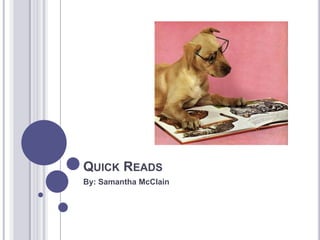
Quick Reads
- 1. QUICK READS By: Samantha McClain
- 2. WHAT IS QUICK READS? Intervention focusing on building fluency, comprehension, and vocabulary through the reading of short content based passages. Five levels A-E, beginning in second grade up to fifth grade Divided by reading grade level Five passages per workbook Three workbooks per level Works increase in difficulty throughout the level and between levels, become longer and with less pictures. Each passage followed by comprehension questions including multiple choice and short answer. Passages are focused on social studies and science content material
- 3. WHEN DO YOU USE QUICK READS? Can be used as an intervention or as part of a curriculum Teachers can decide the pace of the program and tailor it to an individual student Recommended time: Fifteen minutes per day for eighteen weeks At least three times a week, one passage per session Done through one on one interaction with a teacher/tutor or can be implemented in groups.
- 4. HOW DO YOU USE QUICK READS Materials: student workbook(textbook), white board, and a notebook for student answers Three readings of the passage followed by review section All readings are facilitated by the teacher and have structure and modeling imbedded in them At the end of every unit, or workbook, there is a “Connect your ideas” section that connects all the passages in the book to each other.
- 5. FIRST READING Focuses on activating background knowledge of the student Teacher guides the student to look at the pictures, titles, and captions to make predictions about the text Also, the teacher and student identify at least two new vocabulary words that are new to the student and underline them Teacher and student discuss their findings and define the new vocabulary words before the student begins the first reading Students read the passage silently and may use a graphic organizer to help them during the reading Students are looking for key words and passages to help them remember the passage After the initial reading, teacher and student discuss the students findings.
- 6. SECOND READING Modeled reading of the text by the teacher Teacher reads aloud the passage at a rate of one minute per passage (the recommended time for each passage) Teacher must model good prosody, phrasings and fluency for the student After the second reading, teacher and student discuss the main idea of the passage Together they come up with one or two sentences that sum up the passage, or a maid idea phrase.
- 7. THIRD READING Timed silent re-reading of the passage Using the one minute mark as a guide, students time themselves silently reading the passage. Students circle the last word in the passage that was read Using the numbers at the end of each line of text they come up with the number of words read overall Using a chart in the back of the student workbook, students can monitor their progress by recording their reading score. Teacher and student, or group can also read chorally a fourth time for extra practice.
- 8. WRAP-UP Students complete the comprehension section of the workbook which includes the review questions. Teacher facilitates the multiple choice section by implementing strategies without given students the answers Example: Process of Elimination Students complete the short answer question on their own. Teacher discusses answers with students by asking them to explain their findings Teacher can also check for punctuation, grammar, and capitalization in the answer to improve writing skills.
- 9. WHY USE QUICK READS? Based on Dr. Hiebert’s TEXT model Three tasks needed to read successfully: Recognizing familiar words Decoding unfamiliar words Comprehending the text Quick Reads uses this model to develop the difficulty of its passages. Ratio of unfamiliar words to frequent words. Based on the idea that fluency is the biggest obstacle in reading proficiently fourth grade students Based on four strategies for increasing fluency Repeated oral reading Consistent comprehension strategy Making connections between material and prior knowledge Modeling of reading with expression and fluency
- 10. DOES IT WORK? Two studies done by Vardasy and Sanders in 2008 found extensive gains in reading after implementing Quick Reads. 1st study 2nd & 3rd grade students scoring in the 34th percentile Fifteen weeks of Quick Reads instruction Increase in students fluency and word reading accuracy Attributed success to repeated oral reading of content base texts. 2nd study 4th & 5th graders performing below grade level on reading assessments Twenty weeks along with control group Significant gains in vocabulary recognition, passage comprehension and word comprehension.
- 11. PHOTO CREDITS http://www.pearsonschool.com http://www.midland-mi.org teachinglatinamericathroughliterature.wordpress.co m www.wcmlibrary.org bellesbookshelf.blogspot.com yakimavalleylibraries.wordpress.com www.mediapolis.lib.ia.us www.inkity.com Microsoft Office Clip Art